The LG V60 and VELVET Review: A Classic & A Design Restart
by Andrei Frumusanu on July 15, 2020 9:00 AM ESTDisplay Measurement - Typical LG
We mentioned that we have a high suspicion that the V60 and Velvet screen panels are identical, even though there’s a different shape cover glass over both. One further difference between the two phones is their software calibration. The V60 comes with LG’s classic wide range of display profiles (Auto, Cinema, Sports, Game, Photos, Web, Expert) that we’ve seen introduced over the last few years, whilst the Velvet has more significantly simplified things down to only three presents as a custom option (Natural, Vivid, Cinema, Custom).
For the V60, LG’s most accurate preset which actually targets an sRGB gamut is the “Web” profile and that’s what we tested here today. On the Velvet, it unfortunately looks like LG dumbed things down a little too much, as the phone no longer has any profile that’s able to target an sRGB gamut, with all of the available presets targeting some larger colour spaces. We’ve left it on the “Natural” mode as it gave a good enough white-point out of the box.
We move on to the display calibration and fundamental display measurements of the V60 and Velvet screens. As always, we thank X-Rite and SpecraCal, as our measurements are performed with an X-Rite i1Pro 2 spectrophotometer, with the exception of black levels which are measured with an i1Display Pro colorimeter. Data is collected and examined using Portrait Display's CalMAN software.

In terms of brightness, the new LG panels here don’t fare all too well in terms of their maximum brightness. In manual mode, both phones do get brighter than what we typical see of Android OLED devices at around 485 cd/m², but the auto mode under bright environments doesn’t raise this figure much at all, only reaching 525-550 cd/m² on both phones. The auto mode does change the colours and improves contrast for legibility, but can’t really compete with the newer generation Samsung AMOLED panels in terms of brightness.

 Portrait Displays CalMAN
Portrait Displays CalMAN
LG V60
Moving on onto greyscale testing, the LG V60 has some large problems in terms of properly tracking a correct gamma curve. The mid-levels are far too dark, beyond reasonable error rates. The good news is that the colour balance and temperature on the phone is quite good and reaching whites and average colour temperatures of 6600K – a little bit cooler over the 6500K natural sunlight white target, but I prefer this to say Samsung’s usual too warm colour tones.
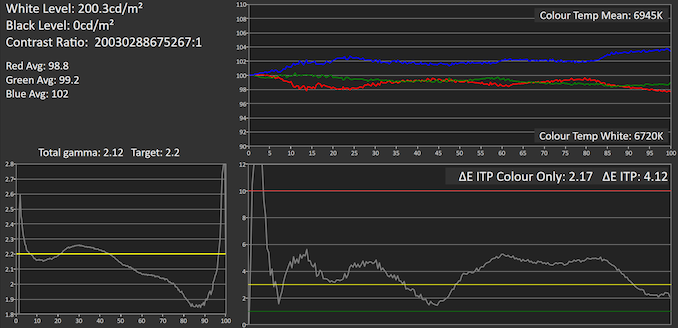
 Portrait Displays CalMAN
Portrait Displays CalMAN
LG Velvet
The LG Velvet’s greyscale results also have issues with the gamma tracking, but this time around it’s on the upper levels where it’s showcasing too low gamma, resulting in tones being brighter than they should be. The Natural colour profile here is also more noticeably cooler, with an average colour temperature of 6945K. It’s possible to fine-tune the colour temperature in the custom settings to alleviate this if it’s a bother.
In the saturations against an sRGB gamut, we see the LG V60 fare quite well when it comes to just the colours themselves. The phone’s biggest issue here is the aforementioned handling of the gamma, resulting in the tones being far too dark.
On the Velvet, as the phone doesn’t actually have a native accurate sRGB mode, it means that all the targets here are way off mark as the “Natural” gamut doesn’t correspond to any particular colour space. This also isn’t a P3 target as the blue hue is significantly different in hue – I don’t know precisely what LG is targeting here if they’re even targeting any standard at all.
In the GMB test with common test tones and colours, the V60 falls flat on its face as the results are outright disastrous. This isn’t too much of a surprise as LG has a long history of making a complete mess of their display colour calibrations in their phones, and the V60 is unfortunately just a continuation of that tradition.
The Velvet, oddly enough, actually fares quite well in the GMB test even though it really shouldn’t be given its non-sRGB gamut. The biggest noticeable difference in the comparison palette is that many of the patches are brighter than they should be, which again points out to the lower than should-be gamut calibration.
Overall, both phones are very clearly LG phones and their colour calibrations are amongst the worst in the market right now. The V60 in particular has just atrocious results given that this was supposed to be an accurate “Web” profile targeting the sRGB space. It’s really unfortunate what the company did here, but after so many years of seeing repeated disaster after disaster, I’ve just come to accept that LG phones simply won’t ever have accurate colours, as sad as that sounds.


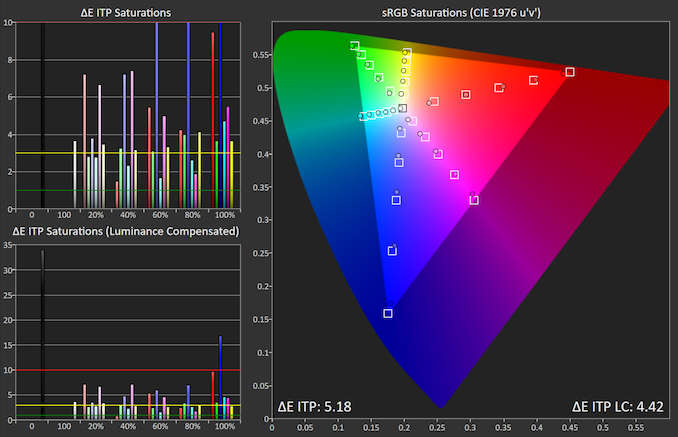
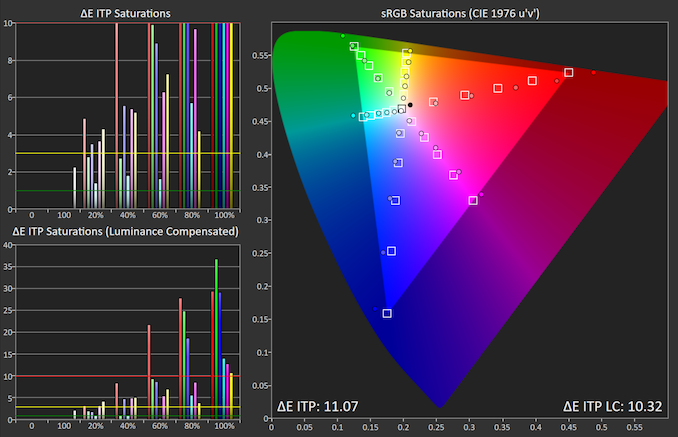
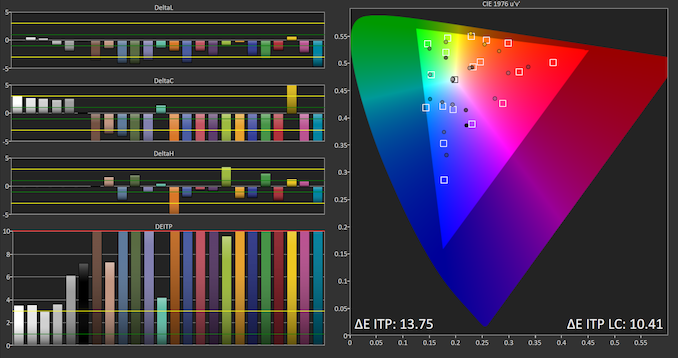

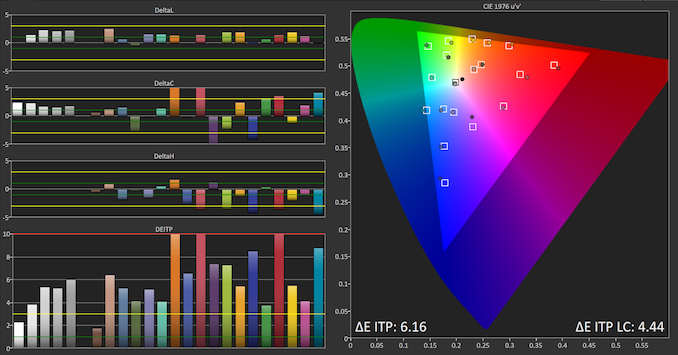









81 Comments
View All Comments
s.yu - Wednesday, July 15, 2020 - link
It's supposed to work, out of the box. Are standard so low these days that people expect phones to automatically break once their software is no longer supported? I just pray that updates don't break my phone.Also flagships should generally be expected to be supported for longer, my backup S6E still got a security update this year(not that I asked for it, but as updates go it kept nagging me to accept), and that was a 2015 device.
TheinsanegamerN - Thursday, July 16, 2020 - link
My moto z play hasnt recieved any updates in 2 years, still works perfectly. Hell my note 4 still technically works (without carrier support) and that thing is ancient.eastcoast_pete - Wednesday, July 15, 2020 - link
I am probably not representative of many here, but I find the "non-contemporary" design of the V60 a big plus. Just having a 3.5 mm connector has become rare amongst the so-called flagship phones. The main issue that make me hesitate to buy another LG is the lack of commitment by the company to keep the OS up-to-date until at least 2023. I've been burned by LG before on that. So, LG, put that commitment in writing, and we might have a deal.TheinsanegamerN - Thursday, July 16, 2020 - link
Android phones dont just stop working when OS updates stop, and even Google wouldnt supply updates that long.My note 4 still loads any modern android app, and its running android 5.0. The apps are still updated and get security updates, the underlying framework doesnt relly matter anymore, anything that does has been tied into the play store by now.
Quantumz0d - Thursday, July 16, 2020 - link
Exactly. The OS app support compat is light years ahead of iOS instead of bending over for the new OS update you can control the phone. And the OS itself is downgrading, people should read on Scoped Storage - It removes your access to your own files, apps need to hit share to make it visible to other apps just like iOS, and folders access doesn't exist, File Management is also hit with this, Developers are hit with this by making POSIX I/O libs optimized for generations are thrown out of window for that SAF abomination with performance hit and a total shitshow on copying Apple. The sad part is no Security updates, that could have been done at CTS level or even Playstore modules but no one cares about that which is what many people would be happier to see.The HW is excellent man for this device but no battery replacement unfortunately, Note 4 is the last of that tech, Uv sensor, removable battery, solid performance, it's a great device. I still have my SGS with aftermarket battery for it's DAC chip of Wolfson Audio.
As for the OP's design I agree about how the V60 maintains the old fantastic unique look than the iPhone / Chinese bump riddled ugly tile.
bhupatib - Wednesday, July 15, 2020 - link
1. ToF camera is not 14um it's 1.42. It's not USB 2.0 but USB 3.1 since they are both capable of Desktop Mode which requires 3.1 with displayport spec.
lmcd - Thursday, July 16, 2020 - link
It's 100% possible to max out at USB 2.0 bandwidth, support PD, and support DisplayPort Alt Mode.mrvco - Wednesday, July 15, 2020 - link
My LG V40 is still going strong and it has grown on me quite a bit since I got it shortly after launch at the end of 2018. I received the update to Android 10 and one security update since. I still use it as my day-to-day phone instead of an XS Max. The good news with LG phones is that as long as you are even a little bit patient there is no need to pay list price. I paid $550 for a NIB V40 a month after launch and full price at T-Mobile for the V60 (single screen) is $699.99 now. Without seeing or holding one, at 599€ (and whatever that ends up being in the US), the Velvet is a tough sell though.s.yu - Wednesday, July 15, 2020 - link
>The good news with LG phones is that as long as you are even a little bit patient there is no need to pay list price.Also true for Samsung phones. More people need to see that :)
Actually the only exceptions may be Apple and the Chinese phones, everybody else you can expect discounts through certain channels shortly after shipping.
patel21 - Wednesday, July 15, 2020 - link
Andrei, please post a similar review for A71 if possible.